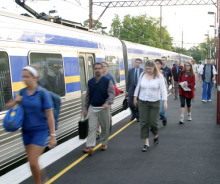Should health be included in transport planning?
18 Jul 2016
The health benefits of walking should be included in cost benefit analysis for urban planning, an expert review suggests.
The NSW Ministry of Health commissioned researchers from the University of Queensland and Deakin University to conduct a review of evidence on The effects of urban form on health: costs and benefits. The review looked at research conducted in Australia and published between 2009 and 2015.
The study found the features of urban form with strongest evidence for promoting physical activity were:
- Distance to public transport
- Aggregated measures of neighbourhood walkability (like Walkscore)
- Access to destinations
- Diversity of land use
The report summarises:
“Broadly, the literature suggests that if people are to walk and cycle, they need destinations within walking and cycling distance.”
The study didn’t look at the impact of access to car parking, due to a lack of Australian evidence, but international studies suggest this is also a major factor.
Estimates of the economic value of walking ranged from $0.38 to $2.10 for every kilometre walked, but the most plausible estimate was $1.68 per km.
The research recommends that physical-activity-related impacts on health should be included in cost-benefit analyses in urban planning. It suggests joint consideration involving both health researchers and urban planners is needed to work out how that might happen.
In urban planning, cost-benefit analysis is most commonly used to evaluate transport projects and prioritise funding. At a conceptual level, including health impacts in transport cost-benefit analysis is unquestionably a good idea. But it could be a case of ‘be careful what you wish for’.
Consider for example a proposed new freeway. Experience tells us that at a general level a new freeway will encourage people to drive and indirectly discourage them from walking. But quantifying that effect is very difficult and might not be included in cost-benefit analysis. Conversely, new freeway proposals are often accompanied by plans for a shared path and it is relatively easy to quantify the positive effect of people walking and cycling on that path.
Incorporating health impacts of physical activity into cost-benefit analysis for transport projects is something that should be advanced and does need further research. But we need to invest to make sure we get it right.
Is the cost-benefit analysis used for transport projects sophisticated enough to give us the right decisions?
Tell us what you think.